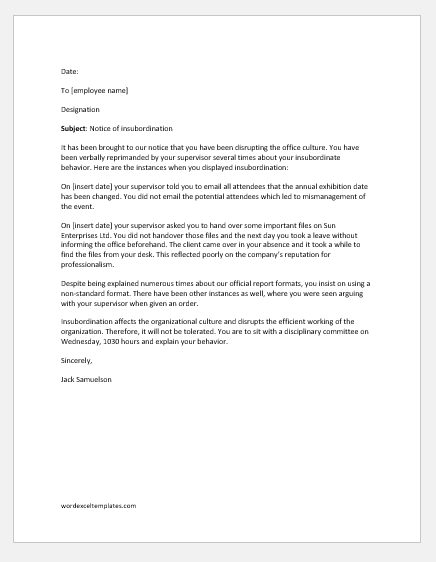Insubordination is refusing to obey a direct order or instruction of the supervisor. It is equivalent of showing disrespect or harassing the supervisor. Insubordination is dealt with seriously to maintain the sanctity of a chain of command in the organization.
Employees cannot be allowed to disrespect supervisors and do as they please. This could potentially disrupt the entire organizational structure. As long as the supervisor’s orders are fair and reasonable, the employees must do as the supervisor says.
Insubordination represents several risks including managerial, financial, and accountability. In a high-risk job such as military, security, technical and engineering jobs insubordination is not tolerable at all. This is because slight insubordination can cause a disastrous situation. Here are some examples of what constitutes as insubordination:
- Refusal to follow a direct order
- Ignoring the supervisor’s instructions deliberately
- Doing the opposite of what has been directed
- Arguing with the supervisor incessantly
- Disappearing when called for work
- Not replying to important emails or communication from the supervisor
Insubordination does not mean that the employee is a slave and must only do as he is told. In real work life, employees are encouraged to put forward their ideas, discuss the best possible solutions to problems and take an active part in achieving organizational goals. To do this, supervisors have over the years also developed a more open attitude towards employees and consider the employee’s valued input.
Nevertheless, the final decision on what to do rests with the supervisor. If the supervisor gives a direct order, it must be obeyed, and the employee then has no margin to disobey or refute an order.
As mentioned earlier insubordination must be addressed seriously or else it can lead to chaos. Every organization has a chain of command that maintains the organizational structure.
Insubordination at one level if not controlled can soon spread over the entire organization destroying the structure and organizational culture. Thus, in the case of insubordination, an employee is sent a notice about his/her behavior and reprimanded for his/her actions.
Sample notice
Notice of Insubordination
Date:
To [employee name]
It has been brought to our notice that you have been disrupting the office culture. You have been verbally reprimanded by your supervisor several times about your insubordinate behavior. Here are the instances when you displayed insubordination:
On [insert date] your supervisor told you to email all attendees that the annual exhibition date has been changed. You did not email the potential attendees which led to mismanagement of the event.
On [insert date] your supervisor asked you to hand over some important files on Sun Enterprises Ltd. You did not handover those files and the next day you took a leave without informing the office beforehand. The client came over in your absence and it took a while to find the files from your desk. This reflected poorly on the company’s reputation for professionalism.
Despite being explained numerous times about our official report formats, you insist on using a non-standard format. There have been other instances as well, where you were seen arguing with your supervisor when given an order.
Insubordination affects the organizational culture and disrupts the efficient working of the organization. Therefore, it will not be tolerated. You are to sit with a disciplinary committee on Wednesday, 1030 hours and explain your behavior.
Sincerely,
Jack Samuelson

